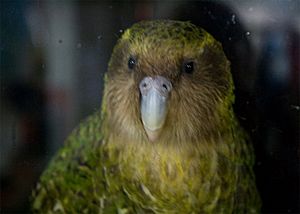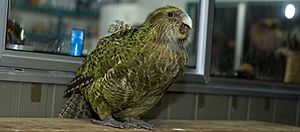Sirocco (parrot) facts for kids

Sirocco in 2010
|
|
| Species | Kākāpō |
|---|---|
| Sex | Male |
| Hatched | 23 March 1997 Codfish Island / Whenua Hou, New Zealand |
| Nation from | New Zealand |
| Occupation | Official Spokesbird for Conservation |
| Known for | Attempting to mate with Mark Carwardine on BBC series Last Chance to See Ambassador for his species and for conservation |
| Parent(s) | Zephyr (mother) Felix (father) |
| biography on DoC website | |
Sirocco is a world-famous kākāpō, a large, flightless parrot from New Zealand that is active at night. He is one of the few kākāpō left in the world, as his species is very rare.
Sirocco became a star after a funny moment on the BBC television show Last Chance to See. During the show, he climbed onto zoologist Mark Carwardine's head and tried to perform a mating dance. A video of this went viral on YouTube, making Sirocco famous around the globe.
Because of his fame, Sirocco was given the special title of "Official Spokesbird for Conservation" in his home country of New Zealand. He helps teach people about protecting nature and his rare species.
Contents
Sirocco's Life Story
Sirocco was born on March 23, 1997, on Codfish Island, a special bird sanctuary in New Zealand. When he was only three weeks old, he got sick with a breathing problem. To save him, conservation rangers had to take him away from his mother and raise him by hand.
Because he was raised by people, Sirocco became imprinted on humans. This means he feels more connected to people than to other kākāpō. For example, he performs the special "booming" sounds that male kākāpō use to attract mates, but he does it for humans instead of female kākāpō.
While this means Sirocco probably won't have any chicks of his own, his comfort with people makes him a perfect ambassador for his species.
A Traveling Ambassador
Since the public cannot visit his protected home on Codfish Island, Sirocco often travels to meet people. Starting in 2006, he made regular appearances on Ulva Island. He has also visited places like the Auckland Zoo and the Zealandia wildlife sanctuary, where thousands of fans came to see him.
In late 2016, the radio transmitter that helped track Sirocco stopped working. For months, a team searched for him. On his 20th "hatchday" in March 2017, they announced that they couldn't find him. Luckily, in February 2018, the team found Sirocco safe and sound. They fitted him with a new transmitter so they could keep him safe.
How Sirocco Became a Star
In 2009, zoologist Mark Carwardine and TV host Stephen Fry were filming on Codfish Island for their show about endangered animals. While they were filming, Sirocco hopped onto Mark's head and tried to get his attention, just like he would with a female kākāpō.
Stephen Fry's funny comment about the moment—"Sorry, but this is one of the funniest things I've ever seen. He thinks you are a female."—made the scene an instant hit on TV. It was shown on news channels all over the world.
A video of the funny incident was put on YouTube and got over 700,000 views in the first week. Today, it has been watched more than 23 million times! After the show aired, Sirocco got his own Facebook and Twitter pages, which quickly gained thousands of followers.
New Zealand's Official Spokesbird
Sirocco's fame helped people all over the world learn about kākāpō. Because he had done so much to raise awareness, the New Zealand government gave him a special job in 2010.
Prime Minister John Key named Sirocco the "Official Spokesbird for Conservation." This was to celebrate 2010 as the International Year of Biodiversity.
Prime Minister Key said, "He's a very media savvy bird, he's got a worldwide fan base... He'll be a great official spokesbird and a great ambassador for New Zealand." This special role shows how one famous bird can help protect his entire species by getting people excited about conservation.
Fun Facts About Sirocco
- A short film about Sirocco's life, called Sirocco – How a Dud Became a Stud, won a major award in 2014.
- Sirocco was the inspiration for the "party parrot," a popular animated emoji used on the computer application Slack.
See also
- List of individual birds


